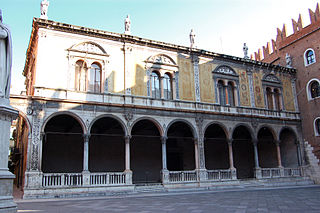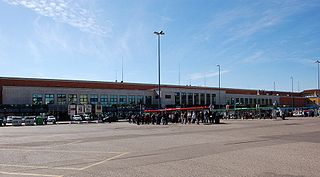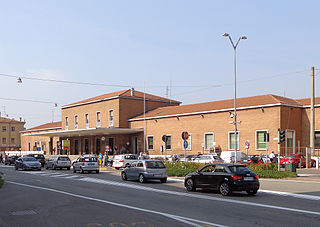
The 1848 Revolutions in the Italian states, part of the wider Revolutions of 1848 in Europe, were organized revolts in the states of the Italian peninsula and Sicily, led by intellectuals and agitators who desired a liberal government. As Italian nationalists they sought to eliminate reactionary Austrian control. During this time period of 1848, Italy was not a unified country, and was divided into many states, which, in Northern Italy, were ruled by the Austrian Empire. A desire to be independent from foreign rule, and the conservative leadership of the Austrians, led Italian revolutionaries to stage revolution in order to drive out the Austrians. The revolution was led by the state of the Kingdom of Sardinia. Also, the uprisings in the Kingdom of Lombardy–Venetia, particularly in Milan, forced the Austrian General Radetzky to retreat to the Quadrilatero (Quadrilateral) fortresses.

The Province of Verona is a province in the Veneto region of Italy. The eastern bank of Lake Garda is near the province. Its capital is the city of Verona. The city is a UNESCO World Heritage Site.
A quadrilateral, in geometry, is a polygon with 4 sides.

Peschiera del Garda is a town and comune in the province of Verona, in Veneto, Italy. When Lombardy-Venetia was under Austrian rule, Peschiera was the northwest anchor of the four fortified towns constituting the Quadrilatero. The fortress is on an island in the river Mincio at its outlet from Lake Garda.

The First Battle of Custoza was fought on July 24 and 25, 1848 during the First Italian War of Independence between the armies of the Austrian Empire, commanded by Field Marshal Radetzky, and the Kingdom of Sardinia, led by King Charles Albert of Sardinia-Piedmont.

The Battle of Cassano d'Adda was fought on 27 April 1799 near Cassano d'Adda, about 28 km (17 mi) ENE of Milan. It resulted in a victory for the Austrians and Russians under Alexander Suvorov over Jean Moreau's French army. The action took place during the War of the Second Coalition during the larger conflict known as the French Revolutionary Wars.

In the War of the Sixth Coalition, the Battle of the Mincio River was fought on 8 February 1814 and resulted in an inconclusive engagement between the French under Eugène de Beauharnais and the Austrians under Field Marshal Heinrich von Bellegarde. Fought on the same ground as Napoleon's victory at the Battle of Borghetto in 1796, the battle was not as decisive as Eugène hoped, and in the end it had little significant impact upon the war, whose outcome was to be decided in France rather than Italy.

The Battle of Castiglione saw the French Army of Italy under General Napoleon Bonaparte attack an army of Habsburg Monarchy led by Feldmarschall Dagobert Sigmund von Wurmser on 5 August 1796. The outnumbered Austrians were defeated and driven back along a line of hills to the river crossing at Borghetto, where they retired beyond the Mincio River. The town of Castiglione delle Stiviere is located 10 kilometres (6 mi) south of Lake Garda in northern Italy. This battle was one of four famous victories won by Bonaparte during the War of the First Coalition, part of the Wars of the French Revolution. The others were Bassano, Arcole, and Rivoli.

The Battle of Bassano was fought on 8 September 1796, during the French Revolutionary Wars, in the territory of the Republic of Venice, between a French army under Napoleon Bonaparte and Austrian forces led by Count Dagobert von Wurmser. The engagement occurred during the second Austrian attempt to raise the Siege of Mantua. It was a French victory, however it was the last battle in Napoleon's perfect military career as two months later he would be defeated at the Second Battle of Bassano, ending his victorious streak. The Austrians abandoned their artillery and baggage, losing supplies, cannons, and battle standards to the French.

In the Battle of Rovereto on 4 September 1796 a French army commanded by Napoleon Bonaparte defeated an Austrian corps led by Paul Davidovich during the War of the First Coalition, part of the French Revolutionary Wars. The battle was fought near the town of Rovereto, in the upper Adige River valley in northern Italy.

The Battle of Goito was fought between the Piedmontese and the Austrian army on 30 May 1848, in the course of the First Italian War of Independence. The Piedmontese army won the battle, as the Austrians were unable to break through to relieve the siege of Peschiera and prevent its surrender which happened on the day before the battle.

During the Siege of Mantua, which lasted from 4 July 1796 to 2 February 1797 with a short break, French forces under the overall command of Napoleon Bonaparte besieged and blockaded a large Austrian garrison at Mantua for many months until it surrendered. This eventual surrender, together with the heavy losses incurred during four unsuccessful relief attempts, led indirectly to the Austrians suing for peace in 1797. The siege occurred during the War of the First Coalition, which is part of the French Revolutionary Wars. Mantua, a city in the Lombardy region of Italy, lies on the Mincio River.
Adam Bajalics von Bajaháza, also Adam Bajalić von Bajaházy or Adam Bayalitsch, entered Austrian military service and fought against Prussia, Ottoman Turkey, and France. During the 1796–1797 Italian campaign against Napoleon Bonaparte, he commanded a brigade or a division in several actions.
The Battle of Borghetto, near Valeggio sul Mincio in the Veneto of northern Italy, took place during the War of the First Coalition, part of the French Revolutionary Wars. On 30 May 1796, a French army led by General Napoleon Bonaparte forced a crossing of the Mincio River in the face of opposition from an Austrian army commanded by Feldzeugmeister Johann Peter Beaulieu. This action compelled the Austrian army to retreat north up the Adige valley to Trento, leaving the fortress of Mantua to be besieged by the French.
In the Battle of Magnano on 5 April 1799, an Austrian army commanded by Pál Kray defeated a French army led by Barthélemy Schérer. In subsequent battles, the Austrians and their Russian allies drove the French out of nearly all of Italy. This action was fought during the War of the Second Coalition, part of the French Revolutionary Wars.

Verona Porta Nuova is the main railway station of Verona, Italy. It is one of the two stations serving central Verona; the other station, Verona Porta Vescovo, is located at the east of the city.

The Battle of Verona was fought on 18 October 1805 between the French Army of Italy under the command of André Masséna and an Austrian army led by Archduke Charles, Duke of Teschen. By the end of the day, Massena seized a bridgehead on the east bank of the Adige River, driving back the defending troops under Josef Philipp Vukassovich. The action took place near the city of Verona in northern Italy during the War of the Third Coalition, part of the Napoleonic Wars.

Mantua Railway Station is the main station of Comune of Mantua in the Region of Lombardy, northern Italy.

The naval operations on Lake Garda in 1866 during the Third Italian War of Independence consisted of a series of clashes between flotillas of the Kingdom of Italy and the Austrian Empire between 25 June and 25 July that year, as they attempted to secure dominance of the lake. The Austrian fleet, based on the eastern bank of the lake, was larger, more modern and better-armed than their Italian counterpart, and successfully maintained control of the waters, hindering the movement of Italian troops.
The Armistice of Treviso was a cease fire signed on 16 January 1801, in Treviso, Italy, between French General Guillaume Brune and the Austrians during the War of the Second Coalition. Brune had defeated Austrian General Heinrich von Bellegarde at the Battle of Pozzolo on 25 December 1800 and drove Generals Josef Philipp Vukassovich and Johann Ludwig Alexius von Loudon from a succession of defensive positions in the mountains. Bellegarde retreated to Treviso and prepared for its defence but agreed to a ceasefire. Under the terms the Austrians ceded many towns in northern Italy but retained Mantua. Napoleon desired the city, which was within striking distance of a French force, and as a result was displeased with Brune, who had promised that Mantua would form part of any armistice deal. However, following French victories in Tuscany and Germany, the French were able to negotiate the ceding of Mantua as part of the Treaty of Lunéville of 9 February 1801.




















